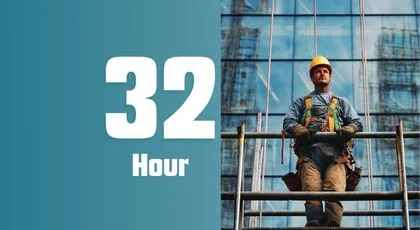16-HR Suspended Scaffold User

Course Duration
16 Hours
Course Session
2-3 Session
Language
English, Spanish
Training Type
Classroom Training
Course Overview
The 16 Hour Suspended Scaffold Safety Training User Course teaches workers how to safely perform duties on suspended scaffolds. The Suspended Scaffold Class is designed for entry level workers who have never worked on suspended scaffolds before. Managers, supervisors, and licensed safety managers and coordinators could also benefit from this course.
During the suspended scaffold user class students will be introduced to OSHA and DOB policies, procedures, and suspended scaffold standards with a detailed overview on prevention and recognition of hazardous conditions. Students will learn how to visually inspect suspended scaffold equipment, suspended scaffold components and methods of assembling/disassembling them. This course also includes a hands-on component where they will participate in presenting, building and using various scaffolding and rigging applications.
Before receiving a scaffold training certificate, students will be assessed on their ability to properly apply rope knots, build a block and tackle system, and operate a hoist motor.
Cost of completion card is included in price indicated below.
Fast Line Safety Training delivers high-quality, hands-on training at your location and provides the industry’s preferred operator card.
Additional Course Information
What you'll learn
- Understand the fundamentals of scaffold design
- Learn to identify and evaluate scaffold hazards
- Develop the skills to work on and around a scaffold safely
- Gain an understanding of fall protection systems
- Recognize and report unsafe scaffold conditions
- Improve your workplace safety
- Develop the knowledge and skills on various types of supported scaffolds
CEU Credits Earned
1.6
Continuous Education Units
Need To Renew Your 16 Hour Suspended Scaffold User Certification?
You may need to renew your 16-Hour Suspended Scaffold certification if:
- Your current certification has expired
- Your employer requires it;
- Industry standards or regulations have changed
- If you feel that your skills need a refresher

Learning Outcomes
By the end of this course, students should be able to:
- Identify types and major components of scaffold systems
- Understand common causes and prevention of scaffold accidents
- Describe applicable OSHA 1926 Regulations and NYC Department of Buildings codes
- Understand General principles of fall protection including minimizing falls, guarding against falling objects, and fall clearance
- Apply proper PPE and Fall arrest system practices
- Apply proper scaffold user safe work practices
- Understand Hoist, platform and rigging equipment practices
- Understand maximum intended loads and capacities reducing factors
- Understand basic rope, fall, knot and hitch configurations and connections
- Apply proper suspended scaffold inspections
Pricing
Group
Minimum 5 person per class-
We Come to You
-
Schedule Flexibility
-
Hands-on Training
Inquire about setting up a private class for your team and ask about group discounts.
To successfully complete the training, students must:
- Earn a minimum score of 75% on the final evaluation.
- Complete 100% of the required course content.
- Completion of required pre-and post-quiz assessment
- Actively participate in all written and practical learning activities.
- Completion of Continuing Education and Training Registration Form
Please note that no make-up time will be provided for missed assignments or activities.
The Preferred Equipment Operator Card

QR Code/ NFC Technology
Digital ID Card: Quickly scan your card with any smartphone camera to experience the convenience of your digital identification profile.
Blockchain Protected
Blockchain-protected: Experience the next generation of security. Leveraging the power of blockchain technology, your cards are encrypted and tamper-proof, ensuring your information is always safe.
ID Cards with Face Photo
Full-resolution ID Cards: Fast Line Safety Training issues A standard identification card featuring a full-color photograph of the individual.
Completion cards are valid for 3 years and in all 50 states.
We are the only providers issuing such permanent cards.
Book your next training course with us.
Fill out the form below or call us at (631) 393 – 6755
to set up your training session!
l out the form below or
call us at (631) 393 – 6755
to set up your training session!

Frequently Asked Questions
Who should take this course?
- Workers who erect, dismantle, alter, inspect, repair, move, or use supported scaffolds
- Workers who work close to scaffolds
- Anyone who needs a comprehensive understanding of scaffold safety
What are the benefits of taking this course?
- Enhance understanding of scaffold safety regulations and best practices.
- Improve knowledge of scaffold erection, dismantling, and inspection procedures.
- Reduce the risk of accidents and injuries related to scaffold use.
- Increase job site safety and efficiency.
- Maintain compliance with OSHA regulations
Will this course help me improve my job performance?
Yes, by increasing your knowledge and skills in scaffold safety, you can improve your job performance, enhance your efficiency, and reduce the time spent on safety-related issues
Will the course address specific safety concerns related to my industry?
While the course covers general scaffold safety principles, the instructor may address specify safety concerns relevant to your industry or the types of scaffold commonly used in your workplace




